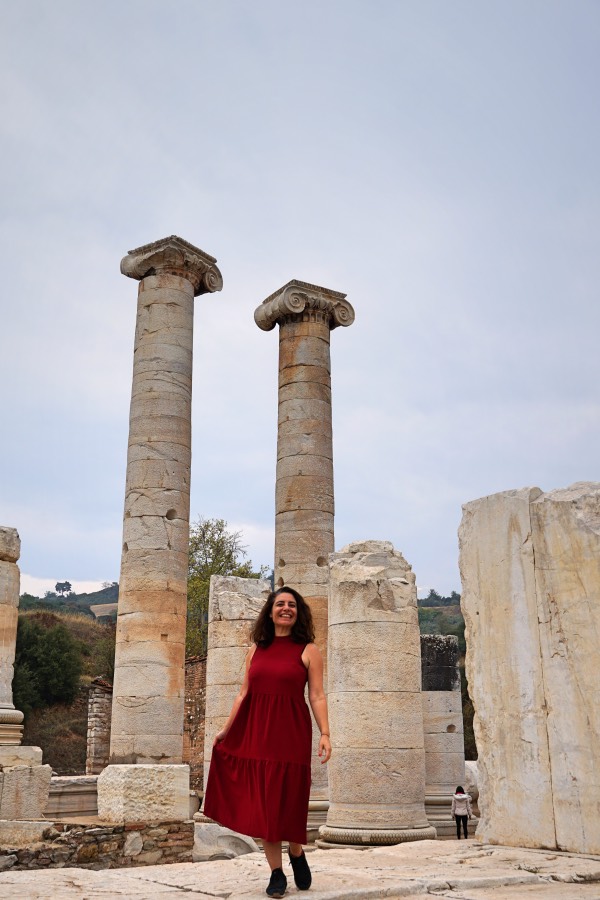The conqueror of lesser-known ancient cities, Who Reads Much Travels, this time takes you to Manisa, the Sart town of Salihli district of Manisa. This time on our route; It was the capital of the Lydian Kingdom, one of the richest civilizations in Anatolia. Sardes Ancient City exists. The ancient city of Sardes, with its 5000-year-old history, strategic location and the place where the money that left its mark in world history is located. Ancient cities you must see in the Aegean It is among the list, definitely add it to your list. Where is Sardes Ancient City, directions, entrance fee, visiting hours, history and places to see and more are waiting for you in this article!
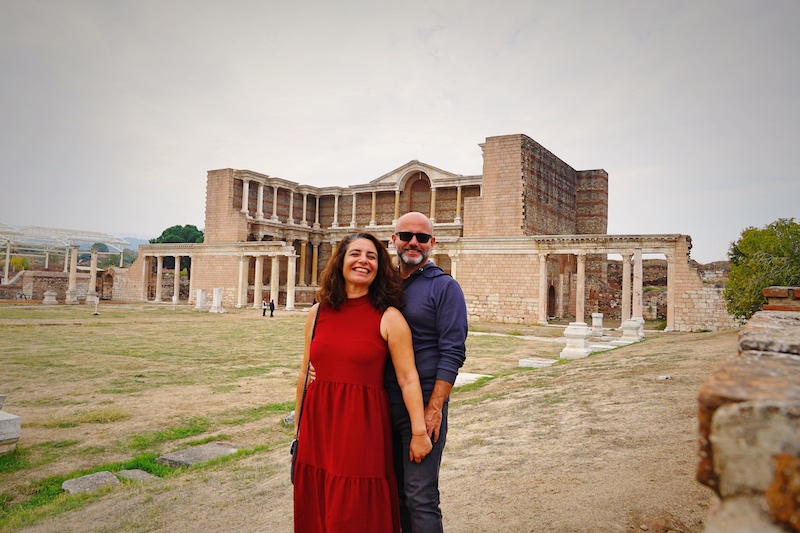
Directions to Sardes Ancient City
Sardes Ancient City is located in Sart town of Salihli district of Manisa, between Turgutlu and Salihli districts. It is approximately 9 km from the center of Salihli, 70 km from the center of Manisa, and 92 km from the city center of Izmir. For directions to Sardes Ancient City and its location on the map click the link.
While continuing from Izmir direction to Uşak, after passing Turgutlu and Ahmetli, you will see the signs for Sardes Antique City 9 km before coming to Salihli. Those coming from the direction of Uşak, 9 km after Salihli, you will see the signposts.
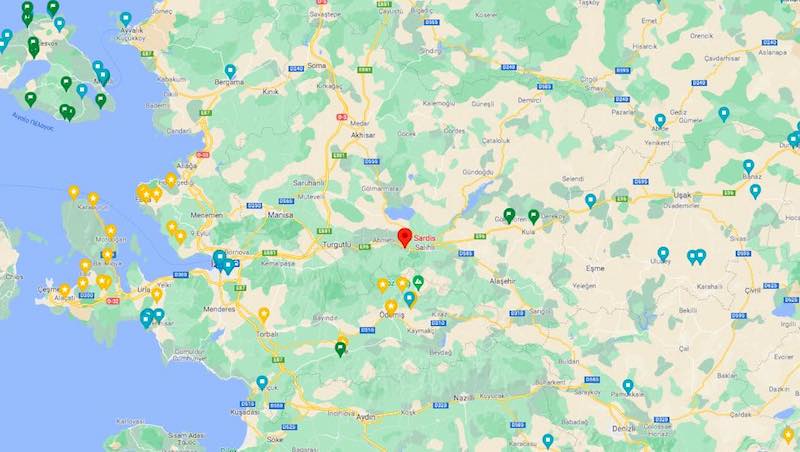
There are two different locations where you can visit the ancient city. The first is the point where the school, bath and sports complex are located, and this is marked on the maps as the Ancient City of Sardes. The second is the point where the Temple of Artemis is. The distance between the two locations is approximately 2 km. They are guided by signboards, and they are also helpful when you ask the box office staff at the entrance.
Sardes Ancient City Entrance Fee and Visiting Hours

Sardes Antique City 2021 entrance fee 17,5 TL, you can visit it free of charge with Müzekart. It is enough to buy a single ticket for two different locations to be seen in the city, and you can visit the one you bought by showing the ticket you bought at the other point.
Sardes Ancient City It is open to visitors between 08:00 in the morning and 17:00 in the evening.
History of Sardes Ancient City
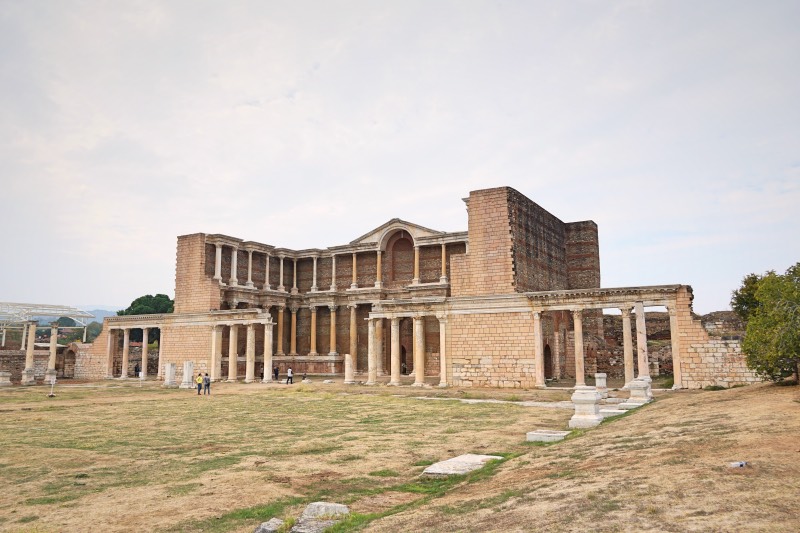
The history of the ancient city of Sardes goes back 5000 years. The ancient city was founded by King Meles on a hill on the skirts of Bozdağ, on the banks of the Sart Stream, which is located on the fertile Gediz Plain and where gold mines were extracted.
The most important feature is undoubtedly that it is the capital and the only Lydian city of the Lydians, the civilization that found money, which we learned in history lessons. The Lydians, who were rich in gold, invented the money (coin) and went down in history as the first place where money was printed under the guarantee of the state. Trade had a very important place in the development of the city, which was enriched with gold. It has become one of the richest cities in Anatolia, thanks to agriculture, livestock, trade and gold mining in the Sart (Paktalos) Stream. Sardis is the homeland of the Croesus (Crocheus), whose name is used to describe wealth. The beginning of the King's Road, which connects the cities in Western Anatolia, is Sardes. Sardes, which has unique features in urban planning thanks to its wealth, is surrounded by the largest defense walls outside of Mesopotamia.
It is estimated that the city looked like this in ancient times:
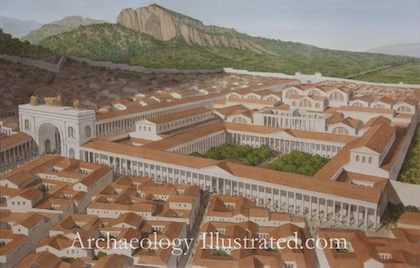
While the Sart River, on the banks of which the ancient city was founded, was an important source of gold mines, gold was exhausted in the river by the Roman Period. However, the city did not lose its importance and became an important bishopric center. It was home to one of the seven churches in Western Anatolia, which played an important role in the spread of Christianity to the west.
Places to Visit in Sardes Ancient City
There are two different areas that can be visited within the borders of Sardes Ancient City. The first is the section where the school, bath and gymnasium complex are located. The second is the section where the Temple of Artemis is located. There is a distance of approximately 2 km between the two sections. Other parts of the ancient city, such as the stadium and the theater, are not open to visitors as the excavations continue. I have listed the places you can see in the sections that are open to visitors below.
Latrina – Toilets

When you enter from the main entrance of Sardes Ancient City, the first place you come across is the latrina, or toilets, belonging to the hammam and gymnasium complex. It is known that in the Roman Period, toilets were open and they were places where needs were met by sitting side by side, important meetings and even meetings were held.
Restaurants and Shops

When you follow the walking path after passing Latrina, you will see shops and restaurants on the left side of the Colonnaded Street. This is where the city's trade revolves, where Silk Road merchants shop and eat. In one of the shops is the Crusader Boat in the photo above.
Colonnaded Street

This is a street 12 meters wide, under which the water and sewage system passes. This street was used for both pedestrians and vehicles. It is the street where Silk Road trade takes place and people from other cities enter the city. When you go, don't forget to find the ground stones where the vehicles leave their wheel tracks as they pass.
School, Bath and Gymnasium Complex

The huge building located right next to the Colonnaded Street belongs to the Turkish bath and gymnasium complex, which has become the symbol of the ancient city of Sardis. The building, which was built in the 2nd century AD during the Roman Period, includes a school, library, sports fields and a bath. In the photo below you can see the section where the pools are located.

Synagogue
The basilica, located in the south of the courtyard in front of the bath and gymnasium complex, was used as a synagogue in the 3rd century AD during the Roman Period. This Synagogue was the third largest synagogue in the ancient world. The synagogue section was closed to visitors due to restoration work when we went in October 2021.
The Temple of Artemis
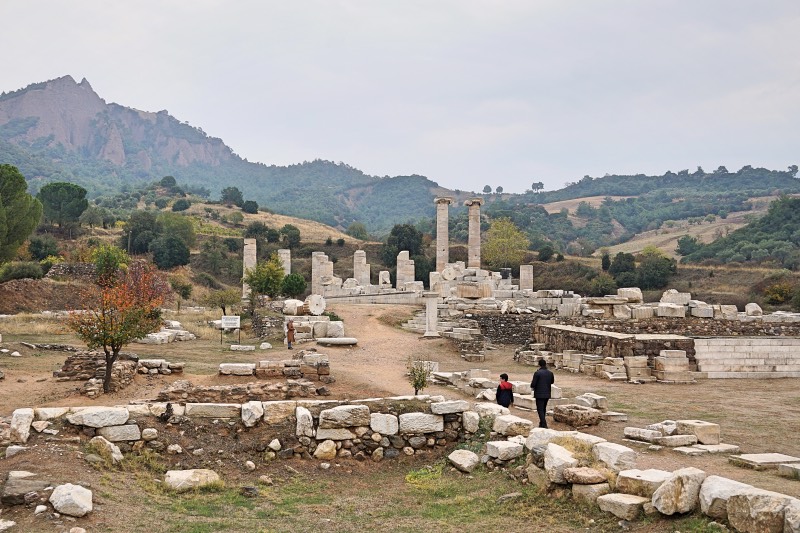
The Temple of Artemis is approximately 2 km from the point where the bath and gymnasium complex is located and has a different entrance gate. I do not repeat the entrance fee information given above.
When you enter the temple area, you first see the boards containing the city excavations and information, and then the crane in the photo below. Upon the invitation of Osman Hamdi Bey, the director of the Istanbul Archaeological Museums, an American excavation team excavated around the Temple of Artemis between 1910-1914 and in 1922, and found the first important finds. The crane is one of the materials used by the American team at that time.
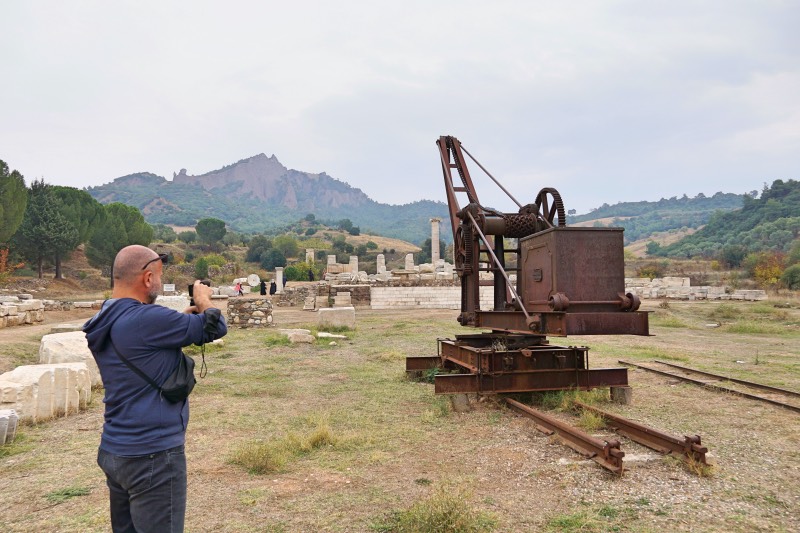
Many column heads and feet remain from the Temple of Artemis, one of the most magnificent Ionian temples in the world, preserved until today. Two columns are still standing. The head and base of each column are different from each other because these columns were made in different periods and by different people. In ancient times, philanthropists could donate columns to temples.
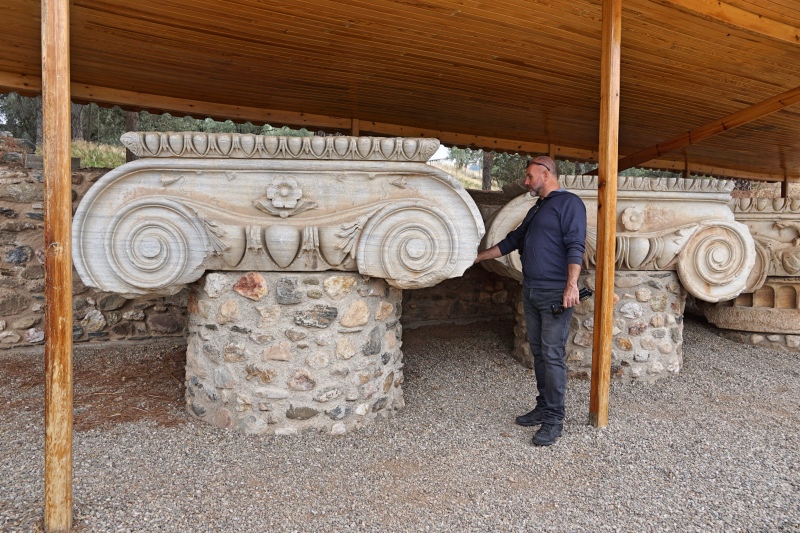
It is estimated that the construction of the temple started during the reign of Lydian King Karun. A similar one to the Temple of Artemis is located in the Ancient City of Ephesus. It was one of the largest temples built in the Ionian style during the Hellenistic period. There were 8 columns across the entrances to the holy places in the interior, and 20 columns along the side wings. The appearance of the temple in ancient times was as follows:
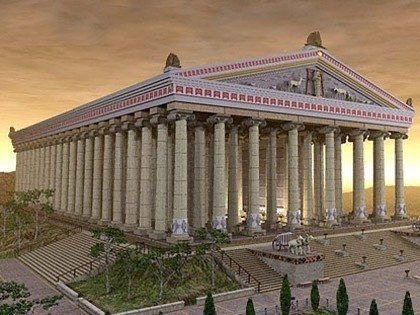
The Temple of Artemis The Temple of Artemis
When Christianity came to the region, the temple lost its importance and a church was built in the southeastern part of the temple in the 4th century. It is called the M Church.
With many information boards around the Temple of Artemis, they explained both the history of the area and detailed information about the structures. The Temple of Artemis for me was an ancient site discovery that impressed me a lot with its columns and size.
Thousand Hills
Sardes Ancient City is also home to the world's largest tumulus site. Located 5 km north of the ancient city, on the southern shore of Lake Marmara, BC. The 6 Lydian King Tombs, dating back to the 5th and 85th centuries, are now called Thousand Hills because they look like tiny hills.
Sardis Ancient City Map
Below is the Sardes Ancient City map. There are two parts of the ancient city that can be visited now. The first is the Gymnasium-Bath Complex, the Synagogue and the Colonnaded Street, and the other is the Artemis Temple. More than 1 kilometer between the two sections, there are separate entrance gates. The Theater and Stadium section is not open to visitors at the moment.
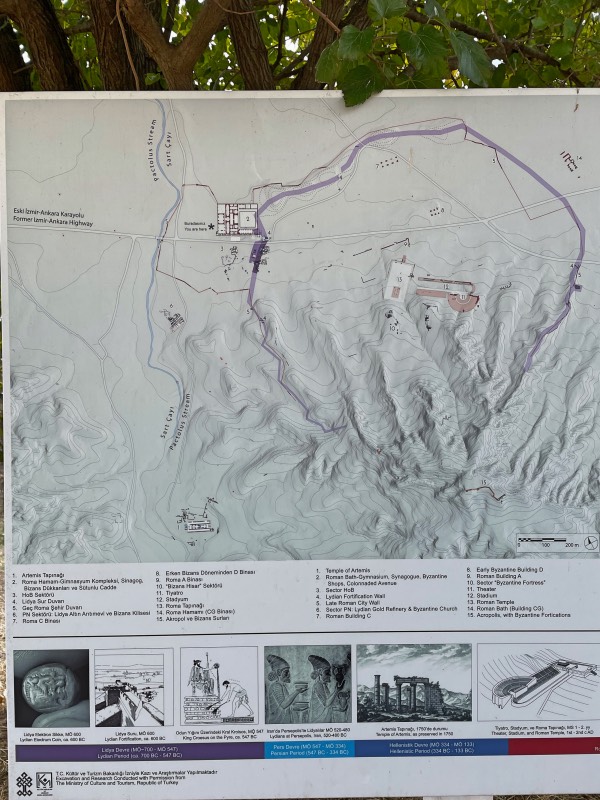
Sardes Ancient City Video
You will see the video I took while visiting the ancient city of Sardes below. I hope you watch the video, like it and even subscribe to my channel.
Sardes Ancient City Photos
You can see all the photos I used in this article below. I would like to remind you that all photos are copyrighted by me.

Sardes Ancient City
Other Places to Visit in Manisa
While you are in Sardes Ancient City, I recommend you to visit other places to visit in Manisa, the list of which you will see below:
- Kula Divlit Volcanic Park
- Sandal Divlit Volcano/Cone located within the Geopark Area
- Historical Kula Houses
- Kula Fairy Chimneys
- Çakırca Basalt Columns
- Tabduk Emre and Yunus Emre Tomb
- Adala Canyon
- Kurşunlu Thermal Springs
- Thermai Thessos Rock Carvings
- Suuçtu Waterfall
- Girl Bridge
Stay on the Road!


